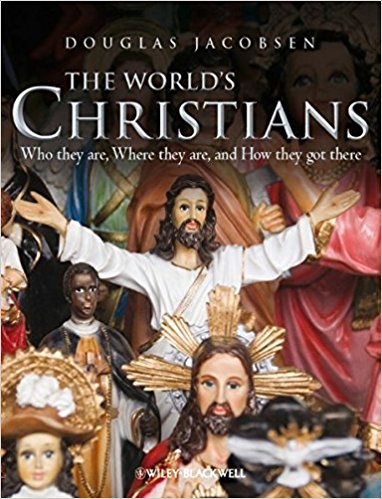The World’s Christians: Who They Are, Where They Are, and How They Got There
- Approximate Time Commitment: 10 minutes
THE WORLD’S CHRISTIANS: Who They Are, Where They Are, and How They Got There by Douglas Jacobsen focuses on the history of Christianity. This book review was written by Hank Griffith of South Suburban Evangelical Free Church in Apple Valley, Minnesota. This book is an easy read for those who are curious about the history of Christians.
Resource Description
Full Review:
The Author
First, a word about the author. The back cover identifies him this way: “Douglas Jacobsen is Distinguished Professor of Church History and Theology at Messiah College. He is author of numerous books … .” What it doesn’t say is that Douglas is my wife Donna’s brother. I’ve known Doug, or “Jake” as we sometimes call him, for four decades, ever since he was an undergraduate at Wheaton College. I’m proud to be able to call Doug my brother-in-law. (And no, he isn’t paying me to write this little review!)
The book
The subtitle clearly lays out the three major divisions of the book – who the world’s Christians are, where they are, and how they got there. The author possesses the ability to amass enormous amounts of information, gleaned not just from reading, but from interviews during numerous trips around the world, and then to summarize it all in a clear way. I found the book not only well researched but also relatively easy to read given the complexity of the content. The pictures, maps, and graphs were fascinating and made the book more readable.
As a historian, Jacobsen has written, for the most part, in a neutral, non-judgmental fashion (i.e., he’s treating his subject matter not as what should be, but what is). Since I’m not a historian but rather an evangelical minister, I read The World’s Christians in a much more subjective and evaluative way. For example, I praised God for the incredible growth of the Church from a group of 120 believers in an upper room to about 2 billion Christ-followers scattered literally all over the world! As I read the book, I was amazed with the extremely different forms Christianity can take. The author states that it can be divided into more than 35,000 different and separate “churchly organizations.” As I reflected on what I was reading, I couldn’t help but occasionally ask myself: What is the core of Christianity? In other words, what is truly necessary for a person or group to be called “Christian”? At times I even tried to think from God’s standpoint, which of course is impossible for any human being: How many of these two billion souls with all their varied beliefs and practices trust in Jesus as Lord and Savior, the condition for eternal life according to the New Testament?
Three branches
I was fascinated by the author’s division of Christianity not just into the usual three branches – Orthodox, Catholic, and Protestant – but a fourth branch, “The Pentecostal/Charismatic Tradition,” which has seen incredibly fast growth over the last century. Why has it attracted so many followers among Protestants, as well as Catholics? What can we learn from this movement? I also appreciated Jacobsen’s perceptive and extensive coverage of Orthodoxy, which most of us evangelicals know so little about.
Always changing
In reading The World’s Christians, I was reminded that nothing is static. The history of the Church is still being written. I thought of the cities in the Middle East and North Africa, once solidly Christian, that now have such a small minority of Christians. I also thought about the highly developed countries today that are rapidly losing ground for the cause of Christ. What will this book look like when it’s rewritten a generation from now? The author ends the book by admitting that this is very hard to predict.
H.G.
Only logged in customers who have purchased this product may leave a review.



Reviews
There are no reviews yet.